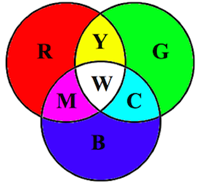
|
Most color printing processes use cyan, magenta, and yellow pigments to create a colored image on a white sheet of paper. Which pigment(s) would have to be imparted to a portion of the paper in order for that portion to appear red when viewed under white light?
|

|
Color Subtraction and Pigments:
Objects are usually viewed under white light. White light can be thought of as an combination of the three primary colors of light - red (R), green (G) and blue (B). Primary pigments are imparted to objects to subtract (absorb) one or more of the three primary colors of light. Any primary color of light that is not subtracted (absorbed) is reflected and thus contributes to the color appearance of the object.
|

|
 Many students of physics have seen a diagram similar to the one shown at the right. The diagram depicts three circles colored with the primary colors of light - red, green and blue. The primary colored circles overlap to produce other colors of light - known as the secondary colors of light: cyan (C), magenta (M) and yellow (Y). These three colors - C, M, Y - are also the three primary colors of paint. The colors of light that they absorb are those directly opposite them on the color wheel. Cyan pigment absorbs red light. Magenta pigment absorbs green light. And yellow pigment absorbs blue light. Many students of physics have seen a diagram similar to the one shown at the right. The diagram depicts three circles colored with the primary colors of light - red, green and blue. The primary colored circles overlap to produce other colors of light - known as the secondary colors of light: cyan (C), magenta (M) and yellow (Y). These three colors - C, M, Y - are also the three primary colors of paint. The colors of light that they absorb are those directly opposite them on the color wheel. Cyan pigment absorbs red light. Magenta pigment absorbs green light. And yellow pigment absorbs blue light.
|

|
Red (R), green (G) and blue (B) light shine upon the paper. The green and the blue light must be subtracted by the paper in order for it to appear red. A primary pigment subtracts a single primary color of light. Two pigments must be painted upon or fixed within the paper to subtract the two primary light colors. So you must answer the question: which pigment will subtract green light and which pigment will subtract blue light?
|